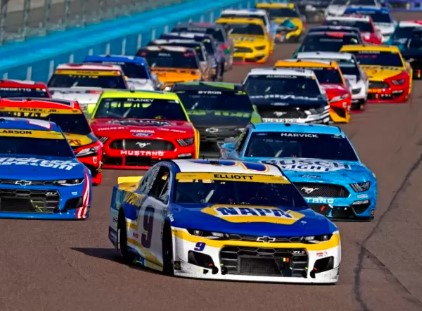
Tight Pack Racing: Navigating the Intense World of Motorsports
In the exhilarating realm of motorsports, few experiences rival the intensity and adrenaline rush of tight pack racing. Whether it’s on the oval tracks of NASCAR, the winding circuits of Formula 1, or the dirt tracks of local racing leagues, tight pack racing tests the skill, courage, and nerve of drivers as they navigate close quarters and high speeds amidst a sea of competitors. In this comprehensive guide, we will explore the dynamic world of tight pack racing, its challenges, strategies, and the electrifying atmosphere that captivates fans and drivers alike.

Understanding Tight Pack Racing
The Essence of Tight Pack Racing
Tight-pack racing, also known as close racing or drafting, occurs when multiple cars or motorcycles race in close proximity to each other, often forming a tightly-knit group or pack. This phenomenon creates a unique aerodynamic effect, as trailing vehicles benefit from reduced air resistance, allowing them to achieve higher speeds and maintain competitive positions.
The Role of Aerodynamics
Aerodynamics play a crucial role in tight pack racing, influencing the handling and performance of vehicles as they navigate turbulent airflows created by nearby competitors. Drivers strategically position their vehicles to exploit aerodynamic advantages, drafting behind lead cars to gain speed on straightaways and executing precise maneuvers to maintain optimal airflow and control through corners.
Mastering the Art of Tight Pack Racing
Skillful Maneuvering
Success in tight-pack racing requires exceptional skill and precision behind the wheel. Drivers must possess a keen understanding of vehicle dynamics, track conditions, and competitor behavior, as they navigate tight spaces and make split-second decisions to avoid collisions and seize strategic opportunities.
Strategic Positioning
Strategic positioning is key to survival and success in pack racing. Drivers must constantly assess their surroundings, anticipate the movements of nearby competitors, and position themselves to capitalize on drafting opportunities while minimizing the risk of contact or accidents. Maintaining situational awareness and adaptability are essential for staying competitive and avoiding potential hazards on the track.
Challenges and Risks
The Danger of Close Quarters
Closely packed racing is not without its risks. The close proximity of vehicles increases the likelihood of contact, collisions, and chain reaction accidents, posing significant safety challenges for drivers and officials. Maintaining control and composure amidst the chaos of tight-pack racing requires nerves of steel and unwavering focus on the task at hand.
The Thrill of Winchester Speedway
Winchester Speedway, nestled in the heart of Indiana. This track is renowned for its high-banked turns, narrow straightaways, and reputation as the “World’s Fastest Half-Mile.” The historic track has been a fixture of American motorsports since 1914, attracting drivers and fans alike with its unique blend of speed, excitement, and danger. Tight-pack racing at Winchester Speedway is a spectacle to behold, as drivers push the limits of speed and skill while battling for supremacy on the treacherous oval.
Strategies for Success
Patience and Persistence
Patience and persistence are virtues in tight-pack racing. Drivers must bide their time, waiting for the opportune moment to make their move and seize control of the race. Pushing too hard too soon can lead to costly mistakes and missed opportunities, while a calculated approach can yield dividends in the closing stages of the race.
Teamwork and Collaboration
In team-based racing series like NASCAR and endurance racing events like the 24 Hours of Le Mans, teamwork and collaboration are essential for success. Drivers work in tandem with their teammates and pit crews. They communicate constantly to share information, coordinate strategy, and overcome challenges on the track. Effective teamwork can make the difference between victory and defeat in the fast-paced world of closely packed racing.
The Thrill of Victory, the Agony of Defeat
Celebrating Triumphs
For drivers, winning in closely packed racing is the ultimate reward for months of preparation, dedication, and sacrifice. Crossing the finish line first, whether by a fraction of a second or a commanding lead. It is a moment of pure exhilaration and vindication, as drivers bask in the glory of victory. As they rush to celebrate their triumphs with teammates, sponsors, and fans.
Enduring Setbacks
However, close contact racing is also unforgiving, with success often elusive and setbacks inevitable. Crashes, mechanical failures, and strategic miscalculations. These can dash hopes of victory in an instant. Thus leaving drivers to grapple with disappointment, frustration, and the harsh realities of motorsports. Yet, it is in these moments of adversity that true champions emerge. This comes as drivers demonstrate resilience and determination. Along with the unwavering resolve to persevere and pursue their dreams.
Conclusion
Tight pack racing is a thrilling and adrenaline-fueled spectacle that captivates audiences around the world. From the high-speed ovals of NASCAR to the challenging road courses of Formula 1. Closely packed racing pushes drivers to the limit, testing their skill, courage, and resolve in the quest for victory. With its blend of speed, strategy, and spectacle, tight pack racing embodies the essence of motorsports. It continues to enthral fans and drivers alike with its electrifying action. Right along with unforgettable moments of triumph and heartbreak.
